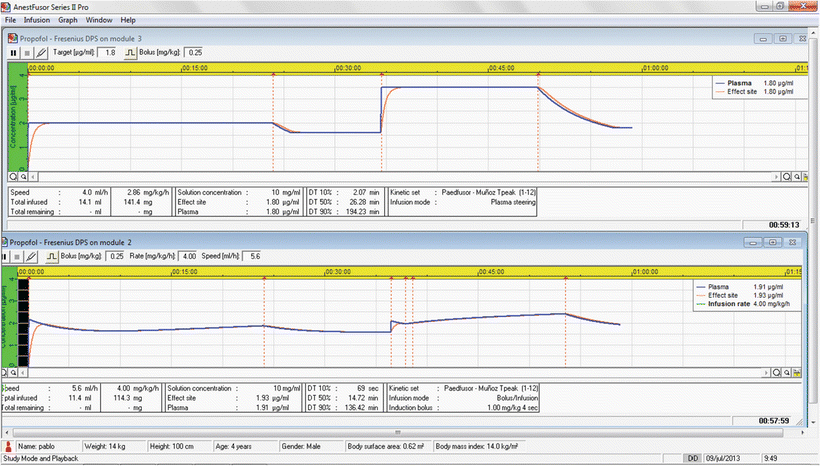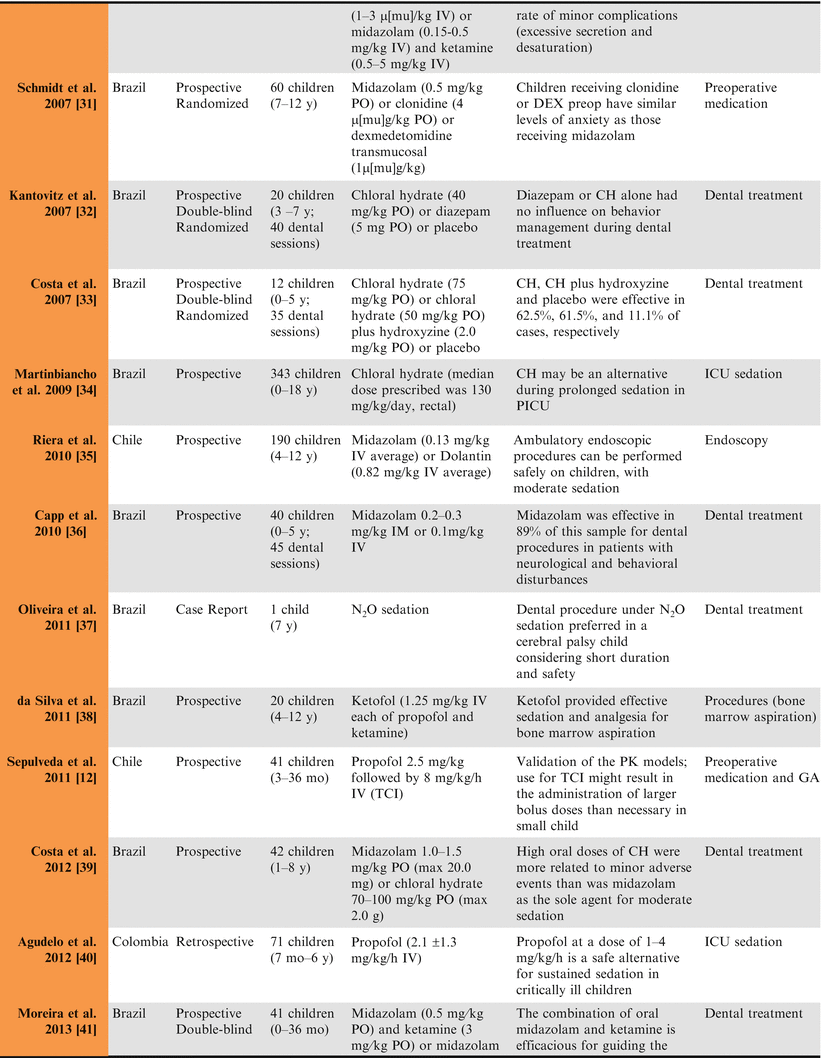Figure 22.1
Left: Ezfusor. Right: Anestfusor. Both control infusion pumps (DPS, Fresenius Kabi)
Argentina
In Argentina tight control is exercised by the Federation of the Associations of Anesthesiology of Argentina2 over the reimbursement for and practice of anesthesiology. This federation has a pediatric anesthesia subgroup, which follows the American Society of Anesthesiologists (ASA) guidelines and policies.
Brazil
In Brazil, there are approximately 9,000 anesthesiologists for a population of about 196 million people (estimated in 2011). There is a concentration of anesthesiologists in large urban areas and a paucity in the northern areas (which includes the Amazon rain forest). The Brazilian College of Physicians (Resolution 1670/2003) supports that deep sedation should only be performed by qualified doctors under conditions in which the procedure is performed by a second, separate professional (physician, dentist). The following should be immediately available: supplies to maintain a patient’s airway, administer oxygen, resuscitate cardiovascular and respiratory complications, and document the sedation (medications, doses, effects, and the criteria for discharge). Clear verbal and written instructions should be given to the patient and guardians upon discharge to detail the medications received, anticipated side effects, and procedure in the event of an emergency.
Brazilian law supports dentists to perform analgesia, sedation, and hypnosis. The Brazilian College of Dentists regulates the delivery of nitrous oxide: Dentists can administer nitrous oxide/oxygen inhalational sedation after attending an approved 96-h course. A recent survey of Brazilian anesthesiologists revealed that 92.8 % do not support the Brazilian College of Dentists statement that “dentists can administer sedation in the dental office” [4]. Rather, although 85.6 % of the anesthesia respondents had rarely or never provided sedation or anesthesia in the dental office, most were not favorable in their support of dentists providing sedation. Ironically, it was those anesthesiologists who had experience with dental sedation and anesthetics that were the most unsupportive of the dentist as a sedation provider [4]. A follow-up survey in 2012 revealed that 77 % of certified dentists in Brazil administer nitrous oxide. Adult patients with physical or mental disabilities were more likely to receive nitrous oxide [5]. To date, the surveys of dental sedation practice in Brazil are not specifically targeted to evaluate the pediatric population. Rather, they are directed to the adult patient population. It is difficult to thus fully ascertain the pediatric dental sedation practice in Brazil. A 2011 survey of pediatric dentists worldwide, however, supported the global popularity of nitrous oxide administration amongst pediatric dentists. Pediatric dentists cited general anesthesia, nitrous oxide, and oral sedation administration with a frequency of 52, 46, and 44 % consecutively [6]. These surveys suggest that the controversy of who is qualified and competent to administer dental sedation spans between countries and continents worldwide [7].
Physicians and dentists who perform outpatient sedation in Brazil usually follow the international guidelines of the American Academy of Pediatrics (AAP) and the American Academy of Pediatric Dentistry (AAPD). There are, however, documents from the Anesthesiology Societies of Rio de Janeiro and São Paulo (Table 22.1) that guide sedation [8, 9].

Table 22.1
Comparison of different guidelines (AAP/AAPD + South America) related to pediatric sedation

One limitation to the practice of safe dental sedation in Brazil is the lack of regulations regarding training, credentialing, and emergency resuscitation skills: Dentists and nurses are not required to have systematic training in medical emergencies (Basic Life Support, BLS; Advanced Cardiovascular Life Support, ACLS; Pediatric Advanced Life Support, PALS) during their formal education or continuing education. Ironically, certification courses for Advanced Life Support in Brazil are directed exclusively to doctors and nurses, forbidding enrollment of dentists.
Chile
In Chile, there are 1,100 anesthesiologists for 17 million people; the biggest challenge is their concentration in large cities. The current accreditation process for anesthesiologists in Chile mirrors those of the Joint International Commission. Pediatric anesthesia is a subspecialty, regulated by the well-established Chilean scientific society,3 which includes clinical guidelines for sedation outside the operating room [10] with the strong recommendation that sedation in children be delivered by anesthesiologists. An exception to this model would be for dentists to administer oral midazolam and nitrous oxide and for radiologists to administer rectal chloral hydrate. The Chilean Dental Society has a pediatric branch that provides regular courses for sedation with nitrous oxide.
The University of Chile has also developed software (Anestfusor; www.smb.cl) to simulate and control the infusion of propofol using pharmacokinetic models (Paedfusor and Kataria), which have been validated in children [11, 12]. (Refer to Chaps. 11 and 31.) In 2011, a study performed in Chile examined the performance of eight propofol pharmacokinetic models in children (3–26 months of age). There was a tendency to underestimate propofol concentration 1 min after the bolus dose, suggesting that there is a risk of delivering a larger initial bolus than intended. Six models were validated in children: Short, Rigby-Jones, Coppens, Kataria, Paedfusor, and Saint-Maurice (Fig. 22.2). Details on TCI and the models are available in Chap. 31.


Figure 22.2
Display of Anestfusor simulator (Anestfusor Serie II Pro software—Facultad de Medicina, Universidad de Chile), which compares manual (top) versus target-controlled infusion (TCI) effect site of propofol delivery (bottom). Note that the proposed target maintains TCI infusion (bottom) despite the requirement for constant adjustment for stability. It is impossible to achieve these end points with manual titration (top). TCI uses specific parametric models with covariates of the treated population
The Paedfusor (Glasgow, UK; pump: Arcomed ag—Swiss—Syramed uSP6000 premium) was developed in the early 1990s as a means to deliver propofol to children using pharmacokinetic models. Today the Paedfusor model is available in the Ezfusor (Anestfusor Serie II Pro software—Facultad de Medicina, Universidad de Chile; http://www.smb.cl/en/anestfusor_serie2_proen.html (Figure 22.1 and Figure 22.2), which has touch screen technology, capable of simultaneously controlling three different drugs in the TCI delivery system. This device is available in more than 20 pediatric hospitals in Chile.
In Chile, the difficulty lies in the complex, remote geography and the need to refer patients to tertiary centers from islands or isolated mountain villages. In many cases, the government supports transport costs in order to ensure the safety of the procedure.
Other Countries
In Bolivia there are no clinical guidelines. In general, the first line plan for sedation is oral midazolam administered by a non-physician (radiology technologist). If the child fails to sedate with that protocol, the child is rescheduled for general anesthesia with halothane to be administered by an anesthesiologist. Propofol is not yet reimbursed by the government and is, thus, less favored to thiopental.
In Colombia, there are published guidelines for the sedation of children over 12 years of age by non-anesthesiologists [13]. These guidelines specify that the sedation must be delivered by a separate provider who performs the surgical procedure. Only one sedative is allowed.
In Peru there are no published sedation guidelines. There is some literature describing the Peruvian experience of administering intravenous midazolam, fentanyl, ketamine, and morphine for procedural sedation [14, 15]. There is also a published review describing the most common drugs used in pediatric dental sedation in Peru: midazolam, diazepam, and chloral hydrate [16].
Common Sedation Techniques and Strategies in South America
As a general rule, it is preferred that children (<than 8 years old) undergo procedures with general anesthesia. In all cases the informed consent, preoperative assessment, monitoring, and documentation mirror that of an anesthetic for a surgical procedure.
In children over 8 years of age, it is possible to use an intravenous sedative technique, ideally after applying a eutectic mixture of local anesthetic cream, which is limited in availability.
Premedications with oral or nasal <0.5 mg/kg midazolam are usually administered 30 min prior to the procedure. The child is then accompanied by a parent or a relative into the procedure room. The sedation may be supplemented with titrated doses of 1 mg/kg subcutaneous or intravenous ketamine and/or propofol TCI. Propofol is usually administered with a Paedfusor target model (1.5–3 μ[mu]g/mL) in progressive steps until the targeted depth of sedation is achieved. Supplemental oxygen is always with standard noninvasive monitoring that meets the ASA guidelines [17].
For painful procedures (lumbar puncture, bone marrow biopsy, fracture mobilization, local anesthetic injection for dental extraction, endoscopy), intravenous alfentanil (6–10 μg/kg) is often titrated at 1-min intervals prior to the stimulus. For colonoscopy and procedures in the emergency department, intravenous fentanyl (1 μg/kg) is preferred at 15-min intervals as required.
In South America there are few established protocols for pediatric sedation. The AAP and AAPD guidelines tend to be followed. The South American protocols are diverging slightly with respect to the qualifications for sedation providers and nil per os (NPO) recommendations (Table 22.1). For example, in the Chilean guidelines, there is a reference specifically to water: 75 mL of water is allowed for children (150 mL for adults) 1 h before sedation [10].
Review of Published Sedation Literature from South America
Over the past 20 years, a variety of sedation literature has been published in South America (Table 22.2) [18–43]. Most of the published studies used midazolam (24; 70.4 %). In 13 of those papers presented in Table 22.2 (68.4 %) midazolam was used as a single drug and its efficacy varied in different scenarios from 66.6 to 89.0 %. Dexmedetomidine, a more recently released drug, was only used in a single study. The most common indication for sedation was procedural sedation (nine papers), followed by its use in dental sedation (seven studies). It is important to highlight that the dental sedation studies used only oral or inhaled routes. In the intensive care units, intravenous sedatives are preferred (one study cites rectal chloral hydrate).



Table 22.2
Data published (PubMed and Scielo) referring to pediatric sedation in South America (1993–2013)



Summary
In South America, there is an enormous variability in sedation practice. The majority of sedation still continues to be administered by anesthesiologists with dentists limited only to nitrous oxide administration and emergency medicine physicians restricted to midazolam, ketamine, and narcotics. There is a huge variability in the culture of research and data collection between countries and regions, and grants for research vary between academic institutions. Although outcome data is scarce, there is now emerging literature on the use of TCI with propofol. With limited financial resources, TCI delivery devices have been created and adapted from existing equipment. Some data published in the literature over the past 20 years (PubMed and Scielo, 1993–2013) on issues associated with pediatric sedation in South America are shown in Table 22.2 and Figure 22.3. Although there is lack of uniform guidelines and recommendations, sedation guidelines for delivery and monitoring tend to follow ASA guidelines.




